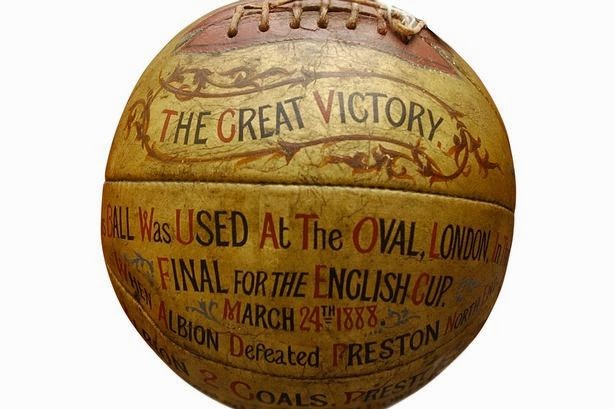Deerstalkers were popular with referees.
When the Football Association’s
Laws of the Game were drawn up in 1863 there was no mention to referees, umpires or any arbiters. However, by the 1870s it was common for association matches to be overseen by two umpires and a referee. This practice is traditionally ascribed to the advent of competitive football with the introduction of the FA Cup in 1871. Of course most football was still played by the class of men who would never knowingly seek to gain unfair advantage or deliberately transgress.
In the Alcock Internationals we see the casual approach to officialdom in keeping with the 'scratch' nature of the matches, the personnel being:
Match 1-No mention made of Umpires and Referees, the assumption being that disputes were settled by the captains.
Match 2-Umpires - Morton Peto Betts (England) and Alexander Morten (Scotland)
Match 3-Umpires - Robert Barker (Hertfordshire Rangers, England) and William Wallace. (Wanderers, for Scotland) Referee - Charles Mansfield Tebbut (Wanderers).
Match 4- Umpires - Alfred Stair (Upton Park, England) and Gilbert Kennedy (Wanderers, for Scotland).
Match 5-Only one Umpire known - Alexander Morten (taken from Andy Mitchell's
First Elevens)
.
In practice each side would nominate an Umpire to whom the captains could appeal regarding any situation that arose during play. This situation was usually adequate, although the Umpires were later described in the press as
12th men on each side who could harass the Referee with pleas and arguments.One Umpire operated in each half of the field (or more accurately each
side of the field- for this purpose the field was divided lengthwise). The Referee could operate from the sidelines, but was often to be found on the field of play.
If we look at the officials involved in the England vs Scotland internationals during the Umpire / Referee era we see a veritable
Who's Who of Victorian football. Prominent football administrators and international players past, present and future fulfilled the roles.
| Referee | Umpires |
|
| England | Scotland |
1872 | William Keay (S) (Hon. Treasurer- Queen's Park) | C.W. Alcock* (Wanderers & Hon. Secretary FA)
| H.N. Smith (President - Queen's Park)
|
1873 | Theodore Lloyd (E) | C.W. Alcock* (Wanderers & Hon. Secretary FA)
| Archibald Rae
|
1874 | Archibald Rae (S) | Alexander Morton* | William Keay
|
1875 | Alfred Stair (E)
| Major Francis Marindin | J.C. Mackay |
1876 | William C Mitchell (S) | J. Turner
| Robert Gardner* |
1877 | Robert A.M.M Ogilvie (E)*
| Hubert Heron* | William Dick
|
1878 | William A Dick (S) | G. Turner | R.B. Colquhon
|
1879 | Charles Wollaston (E)* | A. F. Kinnaird* | R.B. Colquhon
|
1880 | Capt. Donald Hamilton (S) | W. Pierce-Dix (Hon. Sec.- Sheffield FA)
| J. Nicholson |
1881 | Major Francis Marindin (E)
| E.H. Bambridge* | Capt. Donald Hamilton |
1882 | John Wallace (S) | Segar Bastard* | Thomas Anderson
|
1883 | John Sinclair (I)* (Hon. Treasurer- Irish FA ) | J.C. Clegg* (President -Sheffield FA) | Thomas Lawrie
|
1884 | John Sinclair (I)* (Hon. Treasurer- Irish FA ) | Major Francis Marindin | Thomas Lawrie
|
1885 | John Sinclair (I)* | M.P. Betts*
| J. E. McKillop |
1886 | Alexander Hunter (W)*
| N.L. Jackson (Corinthians & Hon. Sec.- FA) | Alexander Stuart |
1887 | John Sinclair (I)* | R.P. Gregson
| R. Browne |
1888 | John Sinclair (I)* | M.P. Betts* | A Mc Kennedy
|
1889 | John Sinclair (I)* | J.C. Clegg* (President -Sheffield FA) | J.A. Crerar (Third Lanark FC & President -SFA) |
1890 | John Reid (I)* | R.P. Gregson
| Charles Campbell* |
1891 | William J Morrow (I)
| S.W. Widdowson* | T.R. Park |
*
denotes an international player.
The inauguration of the British Home Championship in 1883 saw the introduction of neutral referees.
The 1891-92 season saw the Umpires rendered obsolete- replaced by linesmen whose powers were relatively limited, the Referee, by now, having become at least in theory, omnipotent.




































.jpg)














